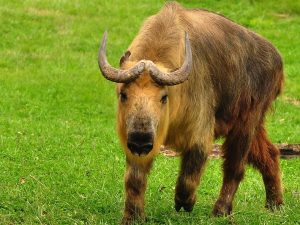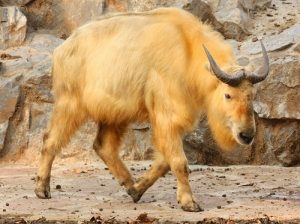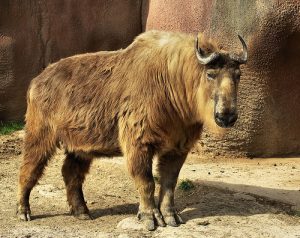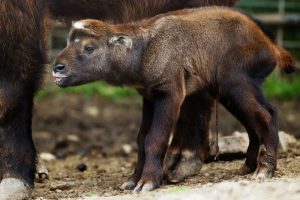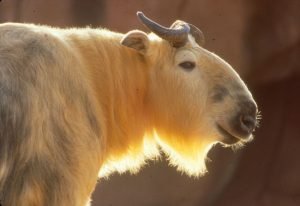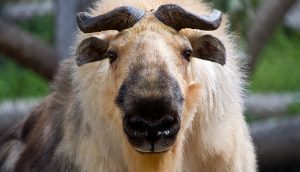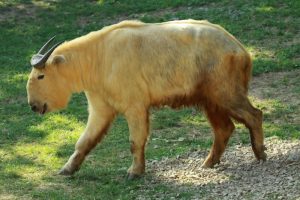Takin
Takin (Pronunciation: Tockin’) are ungulates found in the Eastern Himalayas. Classified as goat-antelopes, they are divided into four subspecies based on their coat color.
Scientific Classification
| Kingdom | Animalia |
| Phylum | Chordata |
| Clade | Synapsida |
| Class | Mammalia |
| Order | Artiodactyla |
| Family | Bovidae |
| Subfamily | Caprinae |
| Tribe | Ovibovini |
| Genus | Budorcas |
| Scientific Name | Budorcas taxicolor |
Quick Information
| Other Names | Cattle chamois, gnu goat |
| Size | Length: Male – 6’9’’-7’2’’ (210-220 cm), Female – 5’6’’ (170 cm) Height: Male – 3’9’’ (120 cm), Female – 3’4’’ (105 cm) Horns: Up to 2’2’’ (64 cm) |
| Weight | Males – 660-770 lbs (300-350 kg) Females – 550-660 lbs (250-300 kg) |
| Color | Reddish brown to golden yellow to yellowish white, with a dark stripe running along the back |
| Distribution & Subspecies |
|
| Habitat | Grass-covered rocky Alpine zones and forested valleys at 3,280-13,940 feet (1,000-4250 meters) |
| Lifespan | Around 16 years |
| Diet | Herbivorous; leaves, twigs, grass, herbs; Travels long distances to get to salt licks |
| Sounds & Communication | Mostly quite; makes snorts, loud whistles, guttural burps, whoops, and bugle-like sounds; Mothers may call their offspring with a high ‘rrrrrr’ sound, , a cough like sound is used to alarm others of danger; males make loud bellows during fights |
| Adaptations |
|
| Predators | Snow leopards are their only confirmed predator; theoretically, Asiatic black bears, leopards, tigers, and dholes can prey on the takin as their habitats overlap |
| IUCN Conservation Status | Vulnerable |
Behavior
Takins live in groups of around 20, especially during winter. During summer they gather in groups consisting of up to 300 individuals to browse vegetation. Older individuals mostly spend their time alone, congregating only during the mating season. Rather slow moving, they spend most of the day in dense vegetation, coming out only to feed. Takins migrate to lower elevations during winter from higher altitudes where they spend summer. Males often engage in horn-fights to assert dominance. Urine scents are used to gauge each others’ status and pedigree. Males spray their chest, forelegs, and face with their urine while females urinate on their tails.
Mating & Reproduction
Takins observe their mating season in July and August. After a gestation period of around 7-8 months, a single baby is born with a weight of around 15 lbs.
Life-cycle
The calves start following their mothers within 3 days of birth. Within a month or two of their birth, they start to follow their mother.
They eventually reach sexual maturity when they are 2½ years old.
Interesting Facts
- Much the giant pandas, the Chinese consider takins as national treasures.
- They are Bhutan’s national animal.
- One of the greatest threats to the takin population is humans, who hunt them regularly for meat and fur.
Published on February 9th 2017 by Sudipto Chakrabarti under Coniferous Forest Animals.
Article was last reviewed on 5th December 2024.


